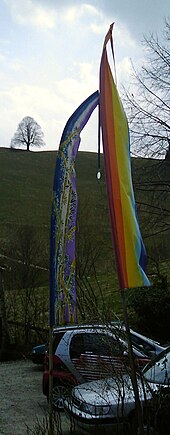Umbul-umbul
Umbul-umbul ( Javanese , Indonesian ), also rerontek (in German called "Bali flag", "Asia flag" or "prayer flag") is a long flag attached to a stick in the folk culture of Java and Bali . It traditionally serves as a banner and has a signal function, is one of the offerings at the Balinese temple and is carried during religious processions.
In old Javanese, the flags were called tunggul . The Indonesian word umbul is adjectivally translated as "grow quickly, shoot up" and means "flagpole". The plural formation in Indonesian is done by doubling the word.
The flags are narrow, about four to five meters long and tapering towards the top. They are attached to a bamboo stick with one long side, the tip is bent down and often decorated with a bell and mirror. Traditionally the umbul-umbul is monochrome. Each color has its special meaning; other colors are used depending on the type of ceremony.
Umbul-umbul are a symbol for the presence of the gods, therefore an important element of celebrations, ceremonies and festivals of Hinduism in Bali , to be found at practically all temples. Umbul-umbul are also carried along during processions , often painted with a snake kite. In addition, they are often found on roadsides and on beaches.
The origin of the umbul-umbul flag is said to be in the Indian area at the time of Buddha . According to the Indian national epic Ramayana , it emerged from a dispute between the hero Arjuna and the monkey god Hanuman . The dragons often depicted on the flags symbolize the arrow of the archer Arjuna.
The common painting (in rainbow colors or colorful motifs according to free imagination) and subsequent setting up of umbul-umbul flags on various occasions and events, as well as artistic garden decoration, has also spread widely in recent years in the wake of the esoteric boom in western culture . In part, the custom in Bali has already been trivialized and commercialized for tourism. An annual flag festival has been held in Bali since 2004, at which a large number of the most beautiful flags are displayed.
Each color of the individual flags has its own meaning. In general, these flags are supposed to bring luck, prosperity and joy, as well as keep away evil forces. Green stands for luck, blue for fertility, white for purity, red for strength and courage and yellow for eternity.
Comparable long flags on bamboo poles and with a similar color symbolism are used in ceremonies of the Maguindanao on the southern Philippine island of Mindanao .
Web links
Individual evidence
- ↑ Umbul-umbul (Balinese Hinduism Flag). balitaksu.com
- ↑ Umbul Umbul Festival imagine-rainbow.ch, 27. – 19. August 2004
- ↑ Mildred F. Accad, Amir Khalid A. Nor, Abraham S. Accad: Tribal flags and Their Significance to the Culture and Traditions of Maguindanaon Tribes in the Pilippines . In: International Journal of Research in Humanities, Arts and Literature, Vol. 3, No. 6, June 2015, pp. 61–70
